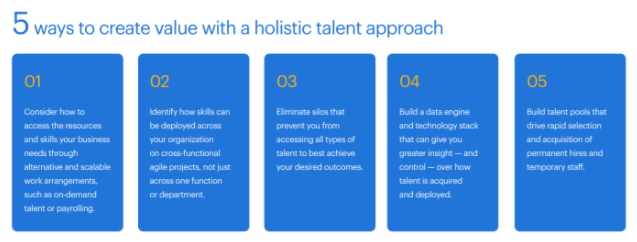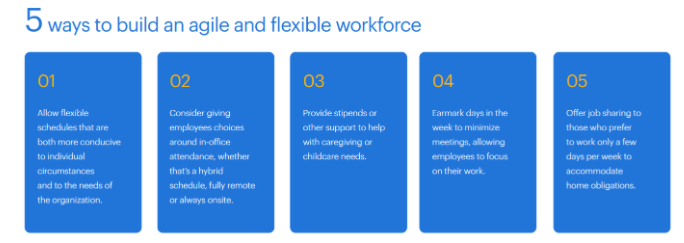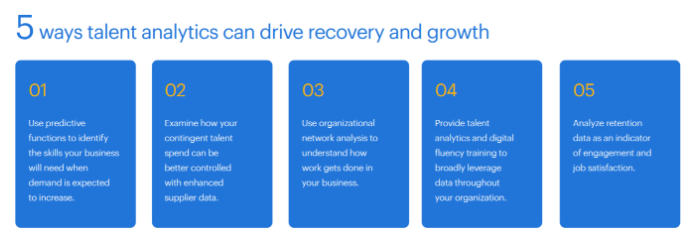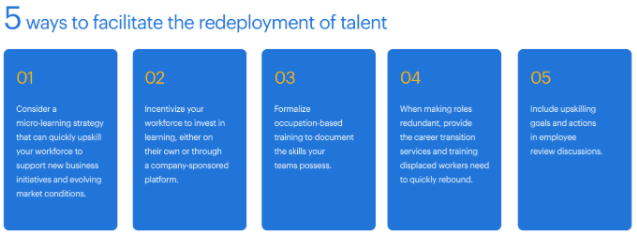Randstad Sourceright’s Top 10 Talent Trends for 2021

2020 was a year of immense and unprecedented challenges, particularly for HR professionals and human capital leaders. From managing accelerating digital transformation, to supporting the world’s workforce through the ‘mass migration’ to remote operations, HR leaders have had to provide guidance, transparent communication and reactive, nimble-minded thinking when it comes to the ever-changing nature of work in a pandemic. Released yesterday, the Randstad Sourceright 2021 Talent Trends Report predicts 10 key trends for human capital leaders to look out for as we forge ahead. This survey of 850 C-suite and human capital leaders in 17 markets across the globe identifies the pain points of these ten trends, examines case studies and provides actionable solutions for how to approach these issues in the extended pandemic and beyond. Summarized below are the Ten Trends and their expected impacts in 2021:
Focus on skills, not jobs to create value
In order to derive as much impact as possible from talent strategies, Randstad researchers recommend leaders prioritize “value over savings.” By this, they mean human capital leaders should be “embracing an optimized blend of temporary and permanent talent and focusing on skills, rather than jobs.” Under these reformed strategies, the focus should shift from “how jobs get filled” to “how work gets done.” Human capital leaders should also prioritize skills that can be deployed across the organisation to maximize deep proficiency and agility.
In order to do so, Randstad suggests the five-step following approach:

Remain flexible in a fluid economy to win
Companies should take the lessons learned from COVID-19 and deploy them throughout 2021 to stay flexible in the face of ongoing economic uncertainty. This overlaps with flexibility in the workforce too, as 64% of human capital leaders surveyed say flexible working arrangements is important to talent attraction. Similarly, a majority (59%) say a “family-first culture” is a robust employee value proposition. 80% of leaders also say their companies are considering some form of permanent work-from-home policy, further driving home the point that flexibility is a top consideration.
To build a more agile workforce, these are the recommendations:

Take workforce health & wellness to centre stage
The stress and strain of 2020 revealed just how critical health and wellness are to employee experience. Randstad research points to meeting or ‘Zoom-fatigue’ and how companies such as Google are looking for ways to counter this by introducing measures such as ‘no meeting weeks.’ “Employers that offer comprehensive support to their stressed workers will likely see returns on their investment in the form of a healthier and more productive workforce,” they report. Furthermore, 62% say a wellness program is extremely or very important to attracting talent.
“Workforce wellness has never been more important, so companies should consider the evolving needs of their employees as circumstances change. More frequent communications and assessments should be a part of your overall talent strategy,” says Wesley Connor, vice president, Global Learning and Development leader Randstad.
Sustain productivity gains with digital transformation
Productivity gains have been one of the ‘surprise’ benefits of the wide scale pivot to remote work last year. In fact, 69% of employers in the Randstad report said their workforce was just as productive or more productive working from home than prior to the pandemic. A lot of this sustained productivity is due to the acceleration of digital transformation, and ongoing productivity will depend on continued investment in this area. Innovation, ‘water-cooler moments’ and connectedness will also be focus areas. “Technology to enhance collaboration and connectivity will remain key to greater productivity, even when large numbers of workers head back to the office,” Randstad researchers write. Currently, 47% are investing in technology to improve the talent experience at work.
Here are five tips to sustain or improve productivity:

Drive workforce decision-making with data
According to the report, talent analytics is the area human capital leaders are investing in the most, with 62% designating “significant” portions of budgets for resources such as data visualization dashboards. Similarly, 46% expect to provide training in data analytics. Accelerated digital transformation goes hand-in-hand with the generation of more data than ever, and human capital leaders should be using these numbers to inform decisions wherever they can, particularly with ongoing COVID-related challenges. As the research points out, “these tools can be used to track health information, talent retention, the location of employees and other important details that will help companies make critical decisions.”

Get ahead of still-growing skills gaps
Skills gaps have become even more apparent during the COVID-19 crisis, as companies (both inside and outside similar industries) are now competing even more fiercely for in-demand, transferable technology (AI, analytics) and people skills (communication, compassion, strategizing, organisational development etc..) According to the report, 40% say talent scarcity has either had a negative impact or been one of their organization’s biggest pain points - the highest this has been in the past five years. To remedy this, Randstad recommends maintaining strong talent acquisition capabilities, assessing upskilling efforts, reexamining value propositions, looking to gig or contingent workers and looking to AI or automation for help with these skills gap struggles.
Reshape the supply chain with borderless talent
In many ways, 2020 dissolved the borders when it comes to recruitment and work, opening up new opportunities to recruit round-the-clock, work-anywhere talent. This has also led to mass migrations away from traditional hubs such as Silicon Valley. Randstad researchers outline, “supported by technology, companies will need to develop more sophisticated sourcing, screening and interviewing capabilities as they expand the scope of their recruitment efforts,” in order to optimize their remote workforce.

Amplify the business case for a culture of diversity & inclusion
Social justice movements resonated through 2020 and it’s important that momentum isn’t lost. Major companies such as Netflix, Nike and JP Morgan are systematically addressing underlying issues through financial investments and dedication to more inclusive working environments. While 80% of respondents say it’s important to have a robust diversity and inclusion strategy to attract and retain talent, this inclusivity must go beyond recruitment and move into every aspect of company culture. Hiring dedicated diversity and inclusion officers is one approach, along with using diversity talent suppliers to “ensure access to underrepresented talent.”
“To create real change, companies need to set solid goals around hiring, supporting and promoting talent from all different backgrounds. Only through tangible actions within their organizations can companies contribute to the broader social justice movement,” said Audra Jenkins, chief diversity and inclusion officer Randstad North America.
Build a sustainable workforce by repurposing talent
By “repurposing” talent, Randstad researchers mean taking existing marketable skills and “refreshing” them or adding in complementary skills in order to facilitate a transition to another industry or profession e.g. airline staff or hospitality staff with people skills could transition to call centre support or medical technicians. Indeed, 92% of respondents said companies themselves should be responsible for this reskilling. “Reskilling and upskilling are more urgent in the time of COVID-19, so organizations that are accelerating their digitalization efforts must make learning a critical component of their business transformation,” said Michel Stokvis, senior director Randstad Innovation Fund and Group Innovation.
Companies can take a five-step approach to this:

Fuel employer brand strategies with your talent experience
More than ever, employer branding is seen as less a way of attracting external talent and more as a key component of the workplace experience and employee engagement. The more companies can do to elevate their brand, mitigate negative perceptions of the organisation and meet employee expectations going forwards, the better for engagement, retention and attraction of talent. This includes employing compassion and effective career transition services, along with support for those who are let go. Human capital leaders should bear in mind that 63% of people believe the talent experience is now more important in a post-outbreak environment and 75% say expectations of employers are continually increasing. As Francesca Campalani vice president, global head of Talent Marketing Randstad Sourceright points out, “the care employers provide to their workforce and their job applicants during this time will resonate with them for years to come, so make sure your business is taking steps to deliver the best experience possible.”
















